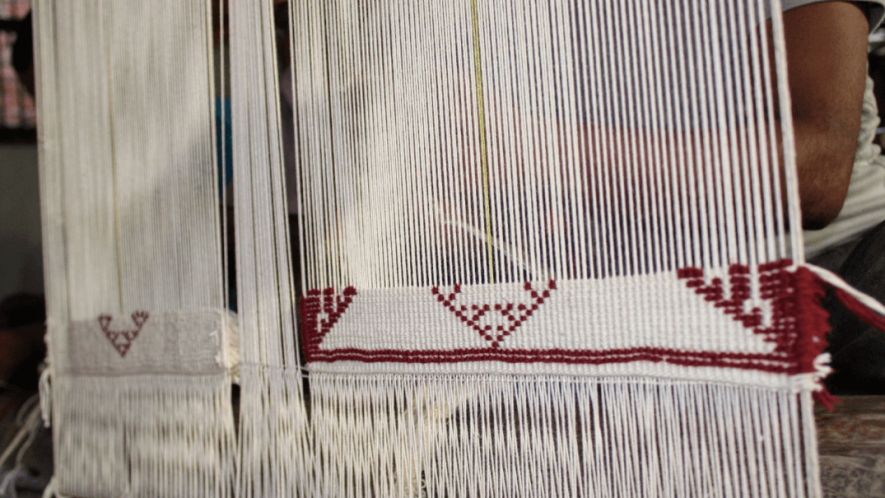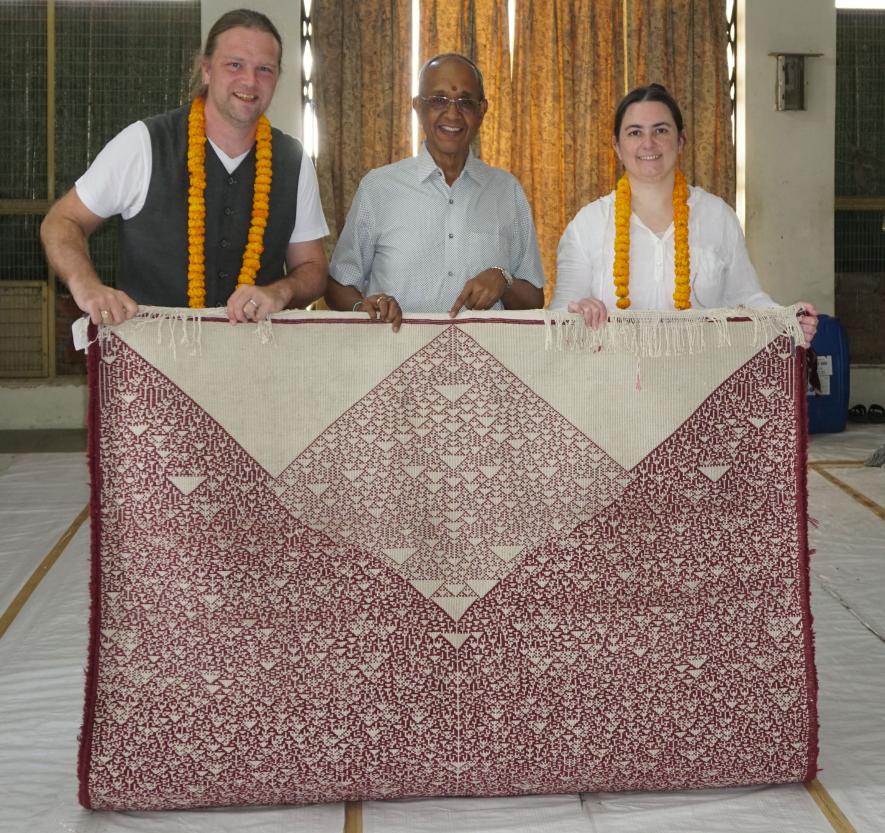Weaving Mathematical Principles Into Indian Carpets

Weaving at the loom: the initial emergence of the pattern in weaving the carpet based on cellular automaton
In India, the tradition of carpet weaving is a very old one; in fact, it can be traced back to centuries. For the admiration of its aesthetics, Indian carpets also have a good international market. Now, this old tradition is meeting a purely mathematical concept to bring out wonderful patterns, thanks to Dr. Tim Otto Roth, the German conceptual artist.
Under the MaSo carpet project, Roth, along with his colleague, Miriam Seidler, developed a simple mathematical rule that has been adopted to weave a carpet. After four months, the project started at a weaver’s village in Bhadohi district of Uttar Pradesh, and a carpet of the dimension of 2.4 and 1.7 meters has come out as a final production. Roth and Seidler with their Indian partner Bholanath Baranwal made every efforts to encourage the weavers to adopt this new idea. Notably, this is also the first time a carpet has been weaved based purely on mathematical idea.

The final carpet with the full pattern weaved with the mathematical concept of cellular automaton.
Traditionally, the carpet weavers use to have a map of the design. They weave the carpets where the design in the map is duplicated by using the logic of tying a carpet row by row. In their loom, the weavers tie the knots among threads of different colours. Their knots weave the pattern of design in the map.
Deviating from this traditional way, Roth’s mathematical formula has a simple rule. The weavers don’t have any previous design to be copied, nor they know what design their carpet will have, they simply have to obey the rule and at the end a pattern emerges out giving the carpet a wonderful design.
The Journey from Germany to India
Roth and Seidler travelled to Bhadohi in December last year to organise a workshop of the traditional weavers of Hussainpura village of Bhadohi district in Uttar Pradesh. Among the 14 weavers that initially took part in the workshop, only a few remained till the end.
When asked what made Roth take up the project in India, he said when he met Bholanath Baranwal for the first time in summer last year in Germany, the Indian carpet manufacturer couldn’t believe that such a simple mechanism would end in an aesthetically satisfying result. But he was open to it and asked the artist a try to visit him in India.
Regarding the challenges they faced in the past four months, Roth said, “Well, the real challenge was the kickoff in December. Surprisingly the initial workshop with the weavers went pretty smooth, simulating the principle with the game "For in a line". But the training at the loom was much harder. The weavers are accustomed to reproduce preconfigured patterns, so in the beginning it was very hard for them to switch off that. For four days we went day by day to the weaver's village, training them by sitting behind the loom to control the weaving process. In the end, it turned out that success depends heavily on the weaver's mindset. Just after we left, two of the three weavers stopped working. But thanks to Bhola's engagement, two other weavers could be engaged and trained. It turned out that this new trio made a great job.”
Above all, there is also a financial issue. “Our method needs more time -- at least in the beginning. This means that the honorary system paying the weavers per square-meter had to be changed into a rate paid per day,” he said.
Tim also said that “for now the project is basic research, which we could realise thanks to the generous support by the museum in Aschaffenburg in Germany. Of course, there is further potential of this new philosophy of carpet weaving”.
Bholanath Baranwal, who owns Shri Bholanath Carpets Limited, and the Indian collaborator of Roth’s project also shared similar views about the challenges that he met in training the weavers-“The most difficult part was to change the mindset of weavers. They are trained and used to weave carpets with the aid of map. It was beyond their apprehension that a carpet can also be hand-knotted without a map.”
Cellular Automaton in Carpet Weaving
In its very first attempt of weaving carpet with mathematical idea, Roth used the concept of Cellular Automaton (CA). “This kind of efforts has never been taken before not only in carpet weaving, but also in other pattern generating techniques. In a way, the project is also a kind of reconstruction, why this never has been tried before in cultural history”, he said.
This concept now a days have extended to the studies of biological systems, physics, complexity science and also microstructure modeling.
CA consists of a regular grid of cells. The grid can be of any finite dimension. The discrete individual cells in a CA exist in one of a finite number of states, for example on or off, 0 or 1 etc. Now the state of any cell at a time can be determined by the states of the neighborhood cells. This is again based on some fixed rules.
The same idea of neighbourhood was used in weaving the carpet. In the first attempt, only two colours are used—the red and the white. Using only these two colours, and following the rule of CA, the pattern of smaller and larger triangles emerged. The design of the carpet is also beautiful.
The rule they followed was a simple one: only if in the previous generation a mummy and a dad stand to the right and left of the newly knotted knot, then a dad will be knotted in the next generation. Dad represents a red thread, mummy represents a white thread. This is a popular game known as the “Four Wins”.
Get the latest reports & analysis with people's perspective on Protests, movements & deep analytical videos, discussions of the current affairs in your Telegram app. Subscribe to NewsClick's Telegram channel & get Real-Time updates on stories, as they get published on our website.















